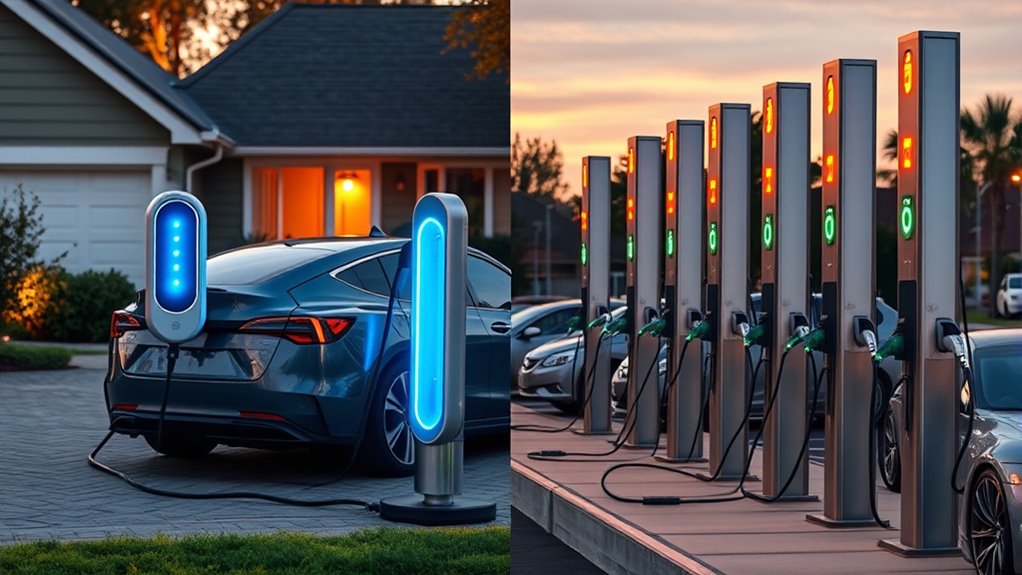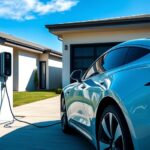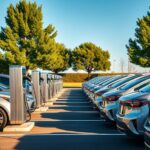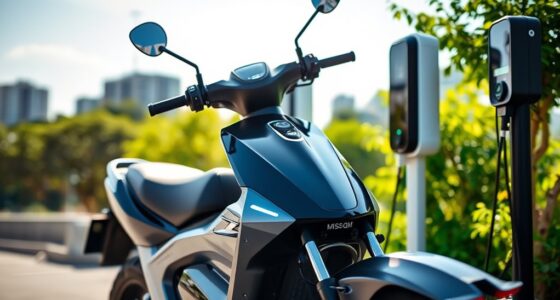Choosing between home and public fast chargers depends on your needs. Home chargers are affordable, convenient, and offer overnight charging, but they take longer—up to 10 hours. Public fast chargers deliver 80% charge in 20-30 minutes, great for quick top-ups on the go, but they cost more and require access to infrastructure. To maximize savings and convenience, understanding the details of each option can help you decide which fits your lifestyle best.
Key Takeaways
- Home chargers (Level 1 and 2) are more cost-effective, with lower per kWh rates and long-term savings.
- Public fast chargers provide rapid charging (80% in 20-30 mins) ideal for quick top-ups during travel.
- Installing a home charger requires electrical system assessment, permits, and possible upgrades, incurring initial costs.
- Public fast chargers tend to be more expensive per kWh due to higher infrastructure and operational costs.
- Combining home charging for daily needs with public fast chargers for long trips offers flexibility and convenience.
Differences in Charging Speeds and Time Requirements

Charging speeds for electric vehicles vary considerably depending on the type of charger used. When you choose home charging options, Level 1 chargers can take up to 20 hours for a full charge, providing about 4 miles of range per hour. Upgrading to Level 2 chargers at home reduces the charging time to 4-10 hours, with a charge rate that adds 25–60 miles of range per hour. Public Level 2 chargers offer similar speeds, typically completing a full charge in 4-8 hours. For quick top-ups during long trips, DC Fast Chargers are your best option, delivering 80% charge in just 20-30 minutes and adding around 100–200 miles of range per half hour. The choice depends on your need for speed and convenience. High refresh rates enhance charging efficiency and reduce wait times, making fast chargers even more appealing for busy schedules. Additionally, advancements in charging technology are continually improving charging times and overall efficiency, emphasizing the importance of charger compatibility for optimal performance. Proper charger maintenance can also impact charging speed and reliability, and staying informed about emerging innovations can help you make better charging decisions.
Cost Implications of Home and Public Fast Charging
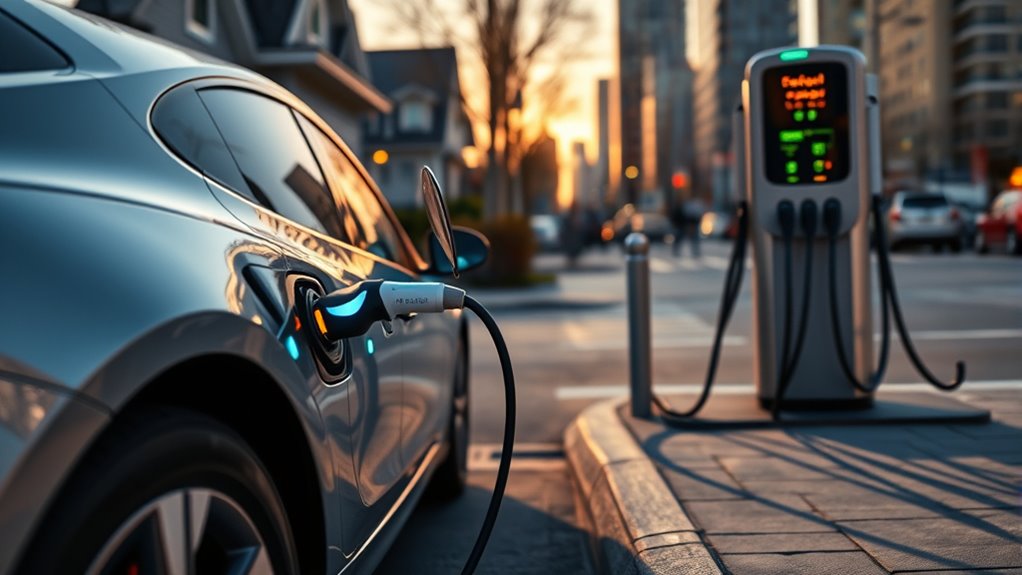
You’ll find that home fast chargers cost less over time due to lower electricity rates, even though the initial setup can be pricey. Public fast chargers charge more per kWh, making them more expensive for frequent use but faster for quick recharges. Considering long-term savings and convenience can help you decide which charging option best fits your needs. Utilizing charging apps can also optimize your charging schedule and costs. Additionally, some best modern toilets can improve your workspace environment, making longer charging times more comfortable. Being aware of essential oils for respiratory health can create a more relaxing environment during extended charging sessions. Understanding curiosity benefits can motivate you to explore new charging technologies and solutions that enhance your overall experience.
Cost per Kwh
Have you ever wondered how much it really costs to power an electric vehicle? The key factor is the electricity, or per kWh, cost you pay at different charging locations. Home charging typically costs around $0.12 per kWh, making it more economical than public fast chargers, which can range from $0.20 to $0.30 per kWh. Public fast charging stations often charge a premium because of higher infrastructure and convenience expenses. Fast chargers, especially DC types, deliver energy quickly but at higher costs—sometimes exceeding $0.30 per kWh. For a full 40 kWh battery, public charging can cost $8–$12, while home charging might only be about $5. The cost comparison depends on energy rates, location, and whether fees are based on energy delivered or time.
Charging Speed Expenses
While the per kWh cost is important, understanding how quickly your EV charges at different stations can substantially impact your expenses. Faster charging speeds at public DC fast chargers mean you get more range in less time but pay considerably higher public charging costs. For example, public DC fast chargers can deliver 80% of a battery in 20-30 minutes, but often cost $16–$24 for a 40 kWh charge—much more than the $6–$8 at home. The rapid energy transfer comes with higher operational costs, making frequent fast charging costly. Additionally, the cost efficiency of charging stations can vary significantly depending on location and infrastructure.
Consider these points:
- Public DC fast chargers charge up to three times more per kWh than home charging stations.
- Level 2 charging stations offer a balance between speed and cost.
- Charging infrastructure impacts your overall charging and public charging expenses.
- Home charging stations provide a cost-efficient option for daily needs.
Long-term Ownership Savings
Long-term ownership savings depend heavily on your charging choices, especially the difference between home charging and public fast chargers. Home charging is typically much cheaper, averaging around $0.16 per kWh, compared to $0.25 or more at public fast chargers. EV owners who primarily charge at home can save about $950 annually on fueling costs, considerably reducing long-term expenses. Investing in a home charging station and utilizing available incentives can further boost ownership savings, offsetting upfront costs. Frequent use of public charging networks increases charging costs due to higher per-kWh rates and access fees. Over the lifespan of your EV, these cost differences add up, making home charging a more economical choice for long-term savings while minimizing overall ownership expenses. Additionally, understanding cost-effective charging options can help maximize savings over the vehicle’s lifetime. Keeping track of your charging habits and exploring utility rate plans can also lead to additional savings and smarter energy use. Moreover, selecting secure payment methods for charging can enhance convenience and security during your charging sessions. Implementing energy management strategies such as smart charging can further optimize your charging schedule for savings and efficiency. Being aware of home charging incentives can also help reduce initial setup costs and improve overall affordability.
Installation and Setup Considerations for Home Chargers

Before installing a home charger, you need to check if your electrical system can accommodate it, including your panel’s capacity and wiring. You’ll also want to verify local permitting rules and electrical codes to guarantee everything is compliant. Safety standards are essential to ensure a secure installation process. Additionally, understanding the juice extraction process can help you choose the most efficient charging setup for your needs. It’s also wise to assess your electrical system’s capacity to prevent overloads and ensure the charger functions reliably. Incorporating fraud prevention tools such as real-time monitoring can help protect your investment during installation and operation. Being aware of cookie management options can also enhance your online experience when researching or booking installation services. Fortunately, incentives like tax credits and rebates can help offset installation costs and make setup more affordable.
Electrical System Compatibility
Installing a home Level 2 charger requires verifying your electrical system can handle the added load. Most chargers run on a 230-volt outlet and demand sufficient panel capacity. You might need electrical upgrades, such as panel or service panel enhancements, which can cost from $1,000 to over $3,000. A licensed electrician must verify your wiring and circuit breaker can safely support home charging. Key considerations include:
- Evaluating your current electrical system’s capacity
- Upgrading panel capacity if needed
- Installing a dedicated circuit breaker for safety
- Ensuring compliance with safety standards and local codes
These steps help prevent overloads, reduce installation costs, and ensure your home’s electrical system is prepared for efficient, safe charging. Proper setup is essential for reliable, safe home charging.
Permit and Code Requirements
Have you checked whether your home’s electrical system meets the requirements for installing a Level 2 charger? You’ll likely need permits and must follow electrical codes to guarantee proper installation. Local regulations often require inspections to verify wiring, grounding, and safety standards are met. Installing a dedicated 240V circuit or upgrading your electrical panel may be necessary if your existing system can’t handle the load. It’s essential to follow manufacturer guidelines and adhere to electrical standards for wiring, conduit, and circuit breakers. Failing to secure permits or comply with regulations can lead to fines, liability issues, or insurance problems if faults occur. Prioritizing proper installation and inspections guarantees safety and ensures your charging setup remains compliant with all local electrical codes.
Cost and Incentive Options
Considering the costs involved in setting up a home EV charger can help you plan your budget effectively. Installation costs for a home charging station typically range from $500 to $1,200, but upgrades to your home electrical system or panel can increase expenses. To offset these costs, rebate incentives and federal tax credits, like a 30% credit, can considerably reduce your investment. Keep in mind that professional installation by a certified electrician ensures safety and code compliance. Before proceeding, assess your electrical capacity—older homes might need panel upgrades exceeding $3,000. Planning ahead for permits and regulations avoids delays.
- Compare home charging costs with public fast chargers and public charging stations
- Take advantage of rebate incentives and tax credits
- Ensure your home electrical system can support a home EV charger
- Factor in installation costs when budgeting for electric vehicle charging
Accessibility and Convenience of Public Fast Chargers
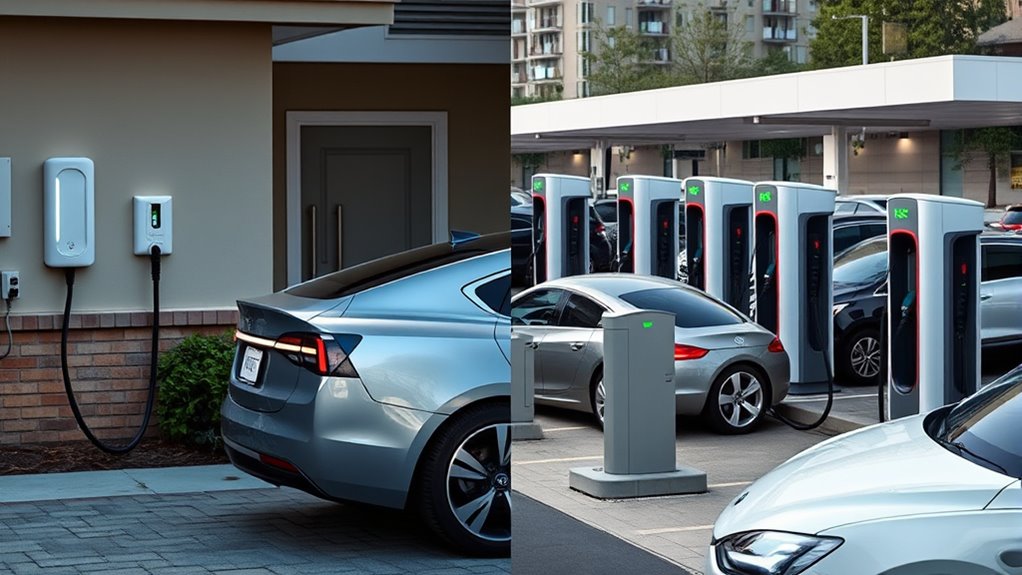
Public fast chargers are designed to make EV charging more accessible and convenient, especially during long trips. With over 168,000 ports nationwide, public chargers are strategically placed along highways and in urban centers, creating a robust charging infrastructure. They offer fast charging, allowing you to regain up to 80% battery capacity in just 20 to 30 minutes, which helps reduce downtime and range anxiety. Accessibility varies by region; urban areas generally have more stations, while rural spots may be limited. Public stations often require payment per session or kWh, impacting overall convenience and affordability. Despite this, the expanding charging network makes EV ownership more practical for those without home charging options, though availability and station reliability can still pose challenges.
Compatibility and Connector Types for Various EVs

Understanding the different connector types is essential to guarantee your EV can charge smoothly at various stations. Most North American EVs use SAE J1772 connectors for Level 2 charging, making them compatible with nearly all non-Tesla public charging stations. For rapid charging, DC fast chargers typically feature CHAdeMO or CCS connectors, but compatibility depends on your vehicle model. Tesla vehicles have proprietary connectors for Superchargers and Wall Connectors, though adapters enable connection to CCS or CHAdeMO stations. Always verify compatibility before arriving at a public charging station to prevent issues. Keep these key points in mind:
- SAE J1772 for Level 2 charging on most EVs
- CHAdeMO and CCS for DC fast charging
- Tesla adapters for broader station access
- Matching connector types to your EV inlet assures smooth charging
Usage Patterns and When to Choose Each Option
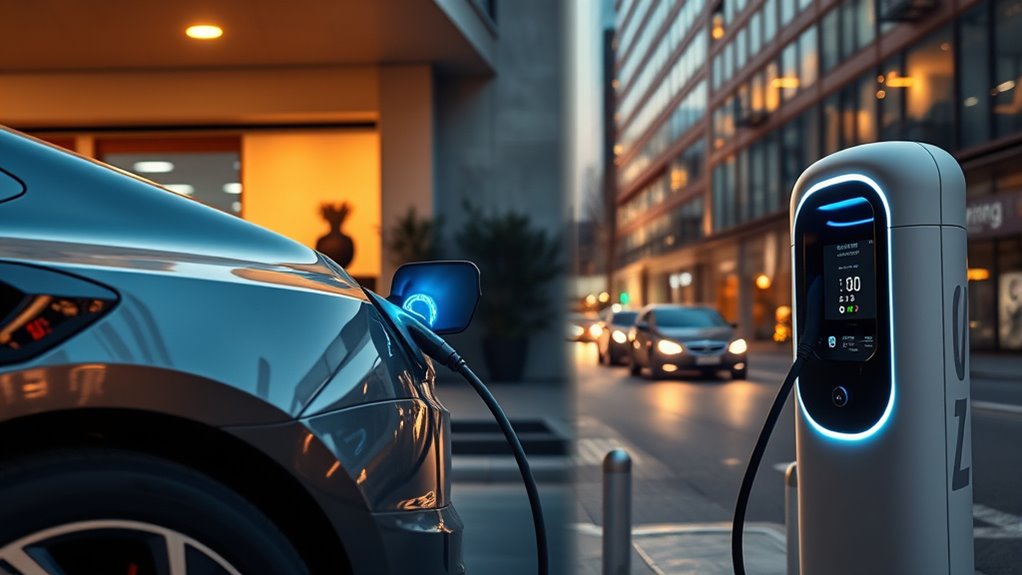
Choosing the right charging option depends on your driving habits and immediate needs. If your daily mileage fits within your EV’s range, home charging at a dedicated station is cost-effective and convenient. Use public fast chargers, like DC fast chargers, during long-distance travel or when quick top-ups are necessary, especially if you lack a home setup. Your usage patterns determine the best choice:
| Driving Pattern | Recommended Charging Option | Key Benefit |
|---|---|---|
| Daily commuting, regular driving | Home charging | Cost savings, convenience |
| Infrequent long trips | Public fast chargers | Speed, efficiency |
| Urgent need or detours | Public fast chargers | Rapid charging |
| Limited access at home | Public fast chargers | Flexibility |
Impact on Long-Term Ownership Costs
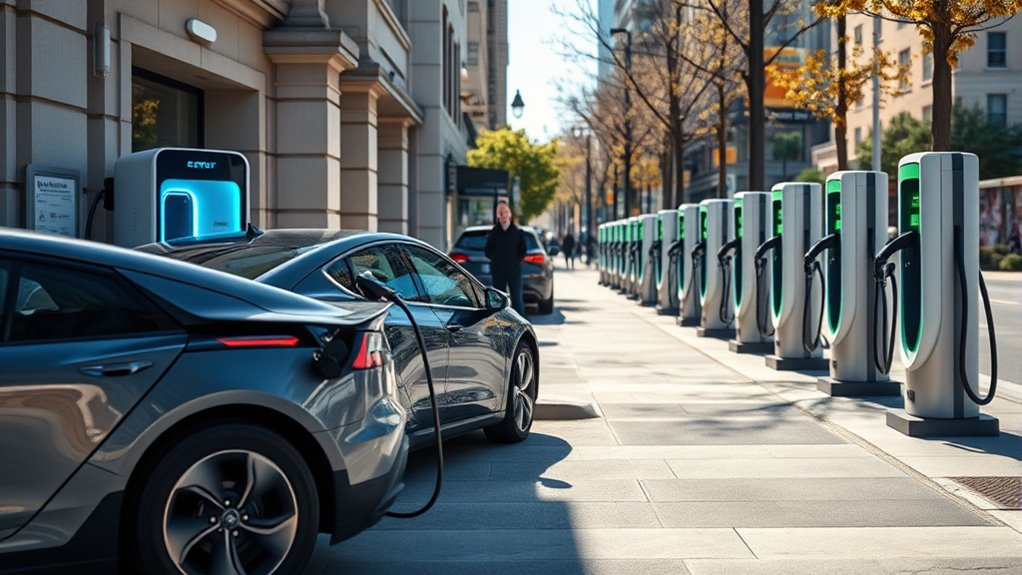
Your charging habits can notably influence your long-term ownership costs. Charging primarily at home with a Level 2 home charger can save you up to $950 annually on fueling costs compared to public fast chargers. Public stations, especially DC fast chargers, are often 2-3 times more expensive per kWh, increasing your charging expenses over time. Additionally, frequent use of public fast chargers may accelerate battery degradation, leading to costly replacements that impact ownership costs. Installing a home charging station, often eligible for federal tax credits up to $7,500, markedly reduces ownership expenses.
Home charging saves up to $950 annually and helps preserve battery health.
- Lower energy savings with home charging
- Reduced battery degradation from avoiding fast chargers
- Decreased charging costs over the vehicle’s lifespan
- Overall ownership expenses stay more manageable
Environmental and Sustainability Factors
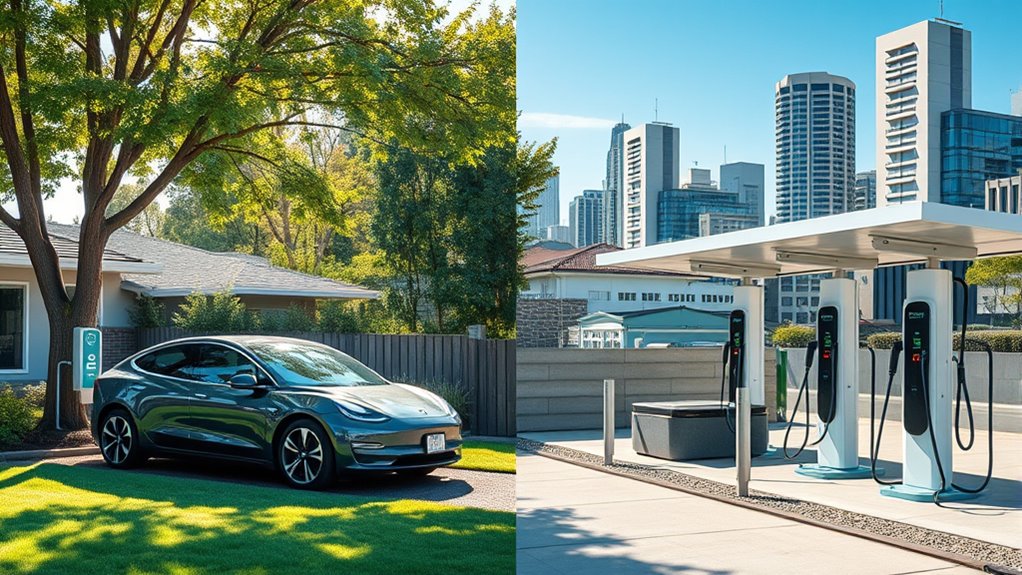
Charging your electric vehicle with renewable energy sources can considerably lower its environmental impact compared to public fast chargers that rely mainly on fossil fuel-generated grid electricity. When you use solar panels or other renewable options at home, you reduce your vehicle’s carbon footprint and support sustainability. Public fast chargers, especially DC fast chargers, often draw power from the grid, which is still largely fueled by fossil fuels, leading to higher emissions. Shifting public charging stations to renewable energy can improve their environmental profile and promote greener EV adoption. Aligning charging practices with climate goals requires moving toward clean energy sources, making EV charging more sustainable and helping reduce greenhouse gases. Ultimately, cleaner energy use benefits both the environment and your contribution to a sustainable future.
Frequently Asked Questions
Is It Better to Charge an EV at Home or at a Public Charging Station?
When deciding where to charge your EV, you should consider cost, convenience, and your driving habits. Charging at home is usually better because it’s cheaper, around $0.12 per kWh, and you can do it overnight, so your battery’s always full. Public fast chargers are faster but more expensive, making them ideal for long trips or when you can’t access a home charger. Think about your daily needs to choose the best option.
What Is the Difference Between Home Charging and Public Charging?
Think of charging your EV like filling a cup. At home, you pour slowly, steadily, saving time and money with each fill. Public stations act like quick-dip refills—fast but more expensive and less convenient. You control the flow at home, enjoying lower costs and comfort. Public charging gets you back on the road swiftly when you’re in a pinch, but it’s a trade-off between speed and expense.
Which Is Better Fast Charging or Rapid Charging?
When deciding between fast and rapid charging, consider your needs. Rapid chargers deliver higher power, charging your EV to 80% in about 20 minutes, ideal for quick top-ups on long trips. Fast chargers are slightly slower but more common and gentler on your battery. If you need speed and your vehicle supports it, rapid charging is better. Otherwise, fast charging offers a good balance of speed and battery health.
Is Charging at Home Cheaper Than Supercharger?
You wonder if charging at home is cheaper than using a Supercharger. The answer is yes, it usually is. Home charging costs around $0.16 per kWh, while Superchargers can range from $0.25 to $0.35 per kWh. You save money by charging overnight, avoiding higher public rates, and benefiting from lower off-peak electricity prices. Over time, this makes home charging the more economical choice.
Conclusion
Whether you prefer the quick convenience of public fast chargers or the cozy comfort of home charging, understanding your options helps you optimize your EV experience. By balancing benefits and barriers, you can choose what best fits your lifestyle, save money, and stay sustainable. Remember, the right recharge routine reduces range worries, saves your wallet, and supports a greener globe. Make your charging choice confidently—comfort, convenience, and cost all come together seamlessly!
